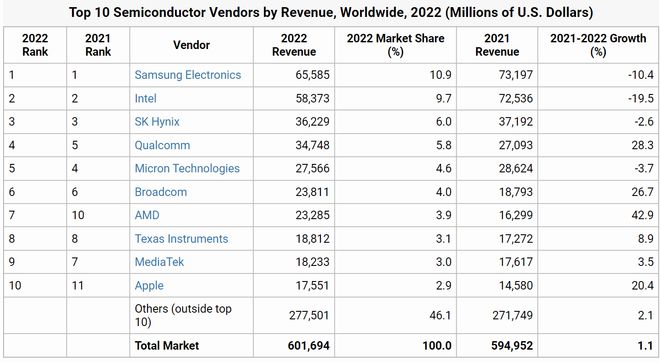

Global semiconductor revenue grew 1.1% to $601.7 billion in 2022, up from $595 billion in 2021, according to preliminary data released by Gartner, according to evertiq. The top 25 semiconductor suppliers recorded total revenue growth of 2.8% in 2022, accounting for 77.5% of the market.
"In early 2022, there was a shortage of many semiconductor devices, resulting in longer delivery times and higher prices, and reduced production of electronic devices in many end markets," Andrew Norwood, vice president analyst at Gartner, said in a press release. As a result, Oems are hedging against shortages by stockpiling chip inventories, "Andrew Norwood continued, explaining that by the second half of 2022, high inflationary pressures, rising interest rates, and increased energy costs are impacting many global supply chains, leading to a significant slowdown in the global economy. That also led to a drop in demand for PCS and smartphones as consumers began to cut back on spending, and then companies began to do the same to prepare for a global recession - all of which had an impact on semiconductor industry growth.
Samsung Electronics retained the top spot despite a 10.4 percent drop in revenue in 2022. The decline in memory and NAND flash sales is the main reason for this. Intel held on to second place with 9.7% of the market. The company's sales growth declined 19.5% due to the significant downturn in the consumer PC market and intense competition in the x86 processor business
Qualcomm and Micron Technology switched places in the rankings, while AMD jumped from 10th to seventh. Mediatek fell to ninth place from seventh last year. One new company in the top 10 is Apple, which nearly made the list the year before (see chart below).

The worst-performing device category in 2022 was memory, with revenue down 10 percent and accounting for about 25 percent of semiconductor sales. By mid-2022, the memory market was already showing signs of a serious drop in demand. While non-memory revenue grew 5.3% overall in 2022, performance varied significantly between device categories. Simulator components grew 19 percent, followed by discrete devices, which grew 15 percent from 2021.